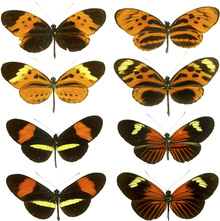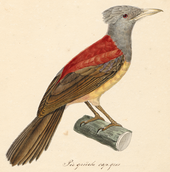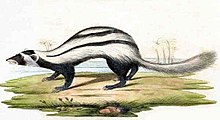Müllerian mimicry

Müllerian mimicryis a natural phenomenon in which two or more well-defendedspecies,often foul-tasting and sharing commonpredators,have come tomimiceach other'shonestwarning signals,to theirmutual benefit.The benefit to Müllerian mimics is that predators only need one unpleasant encounter with one member of a set of Müllerian mimics, and thereafter avoid all similar coloration, whether or not it belongs to the same species as the initial encounter. It is named after the German naturalistFritz Müller,who first proposed the concept in 1878, supporting his theory with the firstmathematical modeloffrequency-dependent selection,one of the first such models anywhere in biology.[a][2][3]
Müllerian mimicry was first identified in tropicalbutterfliesthat shared colourful wing patterns, but it is found in many groups of insects such asbumblebees,and other animals such aspoison frogsandcoral snakes.The mimicry need not be visual; for example, many snakes shareauditorywarning signals. Similarly, the defences involved are not limited to toxicity; anything that tends to deter predators, such as foul taste, sharp spines, or defensive behaviour can make a species unprofitable enough to predators to allow Müllerian mimicry to develop.
Once a pair of Müllerian mimics has formed, other mimics may join them by advergent evolution (one species changing to conform to the appearance of the pair, rather than mutualconvergence), forming mimicry rings. Large rings are found for example invelvet ants.Since the frequency of mimics is positively correlated with survivability, rarer mimics are likely to adapt to resemble commoner models, favouring both advergence and larger Müllerian mimicry rings. Where mimics are not strongly protected by venom or other defences,honestMüllerian mimicry becomes, by degrees, the better-known bluffing ofBatesian mimicry.
History[edit]
Origins[edit]

Müllerian mimicry was proposed by theGermanzoologistandnaturalistFritz Müller(1821–1897). An early proponent ofevolution,Müller offered the first explanation for resemblance between certainbutterfliesthat had puzzled the English naturalistHenry Walter Batesin 1862. Bates, like Müller, spent a significant part of his life inBrazil,as described in his bookThe Naturalist on the River Amazons.Bates conjectured that these abundant and distasteful butterflies might have been caused to resemble each other by their physical environment. Müller had also seen these butterflies first hand, and like Bates had collected specimens, and he proposed a variety of other explanations. One wassexual selection,namely that individuals would choose to mate with partners with frequently-seen coloration, such as those resembling other species. However, if as is usual, females are the choosers, then mimicry would be seen in males, but insexually dimorphicspecies, females are more often mimetic.[5]Another was, as Müller wrote in 1878, that "defended species may evolve a similar appearance so as to share the costs of predator education."[6][7]
Müller's mathematical model[edit]
Müller's 1879 account was one of the earliest uses of a mathematical model inevolutionary ecology,and the first exact model of frequency-dependent selection.[8][9]Mallet calls Müller's mathematical assumption behind the model "beguilingly simple".[10]Müller presumed that the predators had to attack n unprofitable prey in a summer to experience and learn their warning coloration. Calling a1and a2the total numbers of two unprofitable prey species, Müller then argued that, if the species are completely unalike they each lose n individuals. However, if they resemble each other,[8]
then species 1 loses a1n/a1+a2individuals, and species 2 loses a2n/a1+a2individuals.
Species 1 therefore gains n-a1n/a1+a2=a2n/a1+a2 and species 2 similarly gains a1n/a1+a2in absolute numbers of individuals not killed.
The proportional gain compared to the total population of species 1 is g1=a2n/a1(a1+a2) and similarly for species 2 g2=a1n/a2(a1+a2),giving the per head fitness gain of the mimicry when the predators have been fully educated.
Hence, Müller concluded, the proportion g1:g2 was a2/a1:a1/a2,which equalsa22:a12,and the rarer species gains far more than the commoner one.[8]
The model is an approximation, and assumes the species are equally unprofitable. If one is more distasteful than the other, then the relative gains differ further, the less distasteful species benefiting more (as a square of the relative distastefulness) from the protection afforded by mimicry. This can be thought of as parasitic or quasi-Batesian, the mimic benefiting at the expense of the model. Later models are more complex and take factors such as rarity into account. The assumption of a fixed number n to be attacked is questionable.[5]Müller also effectively assumed a step function, when a gradual change (afunctional response[11]) is more plausible.[10]
Non-deceitful mimicry[edit]
Biologists have not always viewed the Müllerian mechanism as mimicry, both because the term was strongly associated with Batesian mimicry, and because nodeceitwas involved—unlike the situation in Batesian mimicry, the aposematic signals given by Müllerian mimics are (unconsciously) honest. Earlier terms, no longer in use, for Müllerian mimicry included "homotypy", "nondeceitful homotypy" and "arithmetic homotypy".[12]
Evolution[edit]
Aposematism, camouflage, and mimicry[edit]
Müllerian mimicry relies onaposematism,or warning signals. Dangerous organisms with thesehonest signalsare avoided by predators, which quickly learn after a bad experience not to pursue the same unprofitable prey again.Learningis not actually necessary for animals whichinstinctivelyavoid certain prey;[13]however, learning from experience is more common.[14]The underlying concept with predators that learn is that the warning signal makes the harmful organism easier to remember than if it remained as wellcamouflagedas possible. Aposematism and camouflage are in this way opposing concepts, but this does not mean they are mutually exclusive. Many animals remain inconspicuous until threatened, then suddenly employ warning signals, such as startlingeyespots,bright colours on their undersides or loud vocalizations. In this way, they enjoy the best of both strategies. These strategies may also be employed differentially throughout development. For instance,large white butterfliesare aposematic aslarvae,but are Müllerian mimics once they emerge from development asadultbutterflies.[15]
Selective advantage[edit]
Many different prey of the same predator could all employ their own warning signals, but this would make no sense for any party. If they could all agree on a common warning signal, the predator would have fewer detrimental experiences, and the prey would lose fewer individuals educating it. No such conference needs to take place, as a prey species that just so happens to look a little like an unprofitable[b]species will be safer than its conspecifics, enablingnatural selectionto drive the prey species toward a single warning language. This can lead to theevolutionof bothBatesianand Müllerian mimicry, depending on whether the mimic is itself unprofitable to its predators, or just a free-rider. Multiple species can join the protective cooperative, expanding the mimicry ring. Müller thus provided an explanation for Bates' paradox; the mimicry was not, in his view, a case of exploitation by one species, but rather amutualisticarrangement, though his mathematical model indicated a pronounced asymmetry.[7][16][9]
Relationship to Batesian mimicry[edit]

The Müllerian strategy is usually contrasted withBatesian mimicry,in which one harmless species adopts the appearance of an unprofitable species to gain the advantage of predators' avoidance; Batesian mimicry is thus in a senseparasiticon the model's defences, whereas Müllerian is to mutual benefit. However, because comimics may have differing degrees of protection, the distinction between Müllerian and Batesian mimicry is not absolute, and there can be said to be a spectrum between the two forms.[17]
Viceroy butterfliesandmonarchs(types of admiral butterfly) are both poisonous Müllerian mimics, though they were long thought to be Batesian.Mitochondrial DNAanalysis of admiral butterflies shows that the viceroy is the basal lineage of two western sister species in North America. The variation in wing patterns appears to have preceded the evolution of toxicity, while other species remain non-toxic, refuting the hypothesis that the toxicity of these butterflies is a conserved characteristic from a common ancestor.[18]
Non-visual mimicry[edit]
Müllerian mimicry need not involvevisualmimicry; it may employ any of thesenses.For example, many snakes share the sameauditorywarning signals, forming an auditory Müllerian mimicry ring. More than one signal may be shared: snakes can make use of both auditory signals and warning coloration.[19]
Negative frequency-dependent selection[edit]
There is anegative correlation between the frequencyof mimics and the "survivability" of both species involved. This implies that it is reproductively beneficial for both species if the models outnumber the mimics; this increases the negative interactions between predator and prey.[19]
Genetics[edit]
Some insight into the evolution of mimetic color mimicry in Lepidoptera in particular can be seen through the study of the Optix gene. The Optix gene is responsible for theHeliconiusbutterflies' signature red wing patterns that help it signal to predators that it is toxic. By sharing this coloration with other poisonous red winged butterflies the predator may have pursued previously, the Heliconius butterfly increases its chance of survival through association. By mapping the genome of many related species ofHeliconiusbutterflies "show[s] that the cis-regulatory evolution of a single transcription factor can repeatedly drive the convergent evolution of complex color patterns in distantly related species…".[20]This suggests that the evolution of anon-codingpiece of DNA that regulates the transcription of nearby genes can be the reason behind similarphenotypiccoloration between distant species, making it hard to determine if the trait ishomologousor simply the result ofconvergent evolution.
Two step evolution[edit]
One proposed mechanism for Müllerian mimicry is the "two step hypothesis". This states that a large mutational leap initially establishes an approximate resemblance of the mimic to the model, both species already being aposematic. In a second step, smaller changes establish a closer resemblance. This is only likely to work, however, when a trait is governed by a single gene, and many coloration patterns are certainly controlled by multiple genes.[21]
Advergence versus mutualism[edit]

The mimic poison frogRanitomeya (Dendrobates) imitatorispolymorphic,with a striped morph that imitates the black and yellow striped morph ofRanitomeya variabilis,a spotted morph that imitates the largely blue-green highland spotted morph also ofR. variabilis,and a banded morph that imitates the red and black bandedRanitomeya summersi.[5][23]

R. imitatorhas thus apparently evolved in separate populations to resemble different targets, i.e. it has changed to resemble (adverged on) those target species, rather than bothR. imitatorand the other species mutually converging in the way that Müller supposed for tropical butterflies.[24]
Such advergence may be common. The mechanism was proposed by the entomologist F. A. Dixey in 1909[25]and has remained controversial; the evolutionary biologistJames Mallet,reviewing the situation in 2001, suggested that in Müllerian mimicry, advergence may be more common than convergence. In advergent evolution, the mimicking species responds to predation by coming to resemble the model more and more closely. Any initial benefit is thus to the mimic, and there is no impliedmutualism,as there would be with Müller's original convergence theory. However, once model and mimic have become closely similar, some degree of mutual protection becomes likely.[9][24]This theory would predict that all mimicking species in an area should converge on a single pattern of coloration. This does not appear to happen in nature, however, asHeliconiusbutterflies form multiple Müllerian mimicry rings in a single geographical area. The finding implies that additional evolutionary forces are probably at work.[22]
Mimicry complexes[edit]
- Many familiarbumblebeesare Müllerian mimics, with effectivestingsand similarwarning coloration
Müllerian mimicry often occurs in clusters of multiple species called rings. Müllerian mimicry is not limited to butterflies, where rings are common; mimicry rings occur amongHymenoptera,such asbumblebees,and other insects, and among vertebrates including fish andcoral snakes.BumblebeesBombusare all aposematically coloured in combinations, often stripes, of black, white, yellow, and red; and all their females have stings,[c]so they are certainly unprofitable to predators. There is evidence that several species of bumblebees in each of several areas of the world, namely the American West and East coasts, Western Europe, and Kashmir, have converged or adverged on mutually mimetic coloration patterns. Each of these areas has one to four mimicry rings, with patterns different from those in other areas.[9]

The relationships among mimics can become complex. For example, the poison fangblennyMeiacanthusspp. have hollow canines and poison glands, and are avoided by predatory fish. The blennyPlagiotremus townsendiresemblesMeiacanthusand is eaten by a variety of predators, so it is a Batesian mimic in their case: but it is avoided by the lionfish,Pterois volitans,making it also a Müllerian mimic.[26]
Sets of associated rings are called complexes. Large complexes are known among the North American velvet ants in the genusDasymutilla.Out of 351 species examined in one study, 336 had morphological similarities, apparently forming 8 distinct mimetic rings; 65 species in another study appeared to form six rings separable by both morphology and geography.[27][28]
Taxonomic range[edit]

Müllerian mimicry was discovered and has mainly been researched in insects. However, there is no reason why the mechanism's evolutionary advantages should not be exploited in other groups. There is some evidence that birds in the New Guinea genusPitohuiare Müllerian mimics.Pitohui dichrousandPitohui kirhocephalus"share a nearly identical colour pattern" where their geographic ranges overlap, but differ elsewhere; they are conspicuous; and they are chemically defended by a powerfulneurotoxicalkaloid,batrachotoxin,in their feathers and skin. This combination of facts implies that the populations in these zones of overlap have converged to share honest warning signals.[29]

Many species offlowersresemble each other but actual mimicry has not been demonstrated.[31]It has been proposed that spiny plants such asCactaceaeandAgavein the Americas,Aloe,Euphorbia,white-thornedAcaciain Africa and spinyAsteraceaeof the Mediterranean may form Müllerian mimicry rings, as they are strongly defended, are generally agreed to be aposematic, have similar conspicuous patterns and coloration, and are found in overlapping territories.[32]
Aposematicmammalsin the familiesMustelidae,Viverridae,andHerpestidaehave independently evolved conspicuous black-and-white coloration, suggesting that Müllerian mimicry may be involved.[30]
In marketing[edit]
The evolutionary zoologistThomas N. Sherrattsuggests that different types of mimicry occur inbrandand productmarketing.He notes that distinctive forms like theCoca-Colabottle's shape are defended by businesses, whereas rival companies have often imitated such famous motifs to benefit from the investment and reputation of their well-known competitors, constituting Batesian mimicry. Sherratt observes that thepackagingof Britishsupermarketown brands ofpotato crispsare consistently colour-coded red for the ready-salted variety, green for salt and vinegar, and blue for cheese and onion,[d]across the major chainsSainsbury's,Tesco,Asda,andWaitrose.He argues that this sharing of pattern is very unlikely to have arisen by chance, in which case the resemblance is intentionally to inform customers reliably (honest signalling) of what each package contains, to mutual benefit in the manner of Müllerian mimicry.[5]
See also[edit]
Notes[edit]
- ^Thomas Malthus's use oftables of numbers illustrating the limits to human population growthis one of the few earlier uses of a mathematical argument that could be called a model.
- ^Unprofitability may consist of anything which makes prey not worth a predator's while to eat. Unpalatability on grounds of toxicity or foul taste is a common mechanism, but defences may include sharp spines; an aggressive nature; agility or speed in escape rendering the prey costly to catch; foul smell, and so on.[9]
- ^Drones have no sting, but similar patterns, and may (more or less accidentally) benefit fromautomimicryof females of their own species.[9]
- ^Sherratt notes that this use of red is shared with Walker's crisps, whereas the uses of blue and green are interchanged with respect to Walker's.[5]
References[edit]
- ^Meyer, A. (2006)."Repeating patterns of mimicry".PLOS Biol.4(10): e341.doi:10.1371/journal.pbio.0040341.PMC1617347.PMID17048984.
- ^Müller, Fritz(1878). "Ueber die Vortheile der Mimicry bei Schmetterlingen".Zoologischer Anzeiger.1:54–55.
- ^Müller, Fritz(1879). "ItunaandThyridia;a remarkable case of mimicry in butterflies. (R. Meldola translation) ".Proclamations of the Entomological Society of London.1879:20–29.
- ^Ritland, D.;L. P. Brower(1991). "The viceroy butterfly is not a Batesian mimic".Nature.350(6318): 497–498.Bibcode:1991Natur.350..497R.doi:10.1038/350497a0.S2CID28667520.
Viceroys are as unpalatable as monarchs, and significantly more unpalatable than queens from representative Florida populations.
- ^abcdeSherratt, T.(2008)."The Evolution of Müllerian Mimicry".Die Naturwissenschaften.95(8): 681–695.Bibcode:2008NW.....95..681S.doi:10.1007/s00114-008-0403-y.PMC2443389.PMID18542902.
- ^Forbes 2009,pp. 40–42.
- ^abRuxton, Speed & Sherratt 2004,pp. 116–118.
- ^abc"Fritz Müller in 1891".Retrieved18 November2017.
- ^abcdefMallet, James(2001). "Causes and consequences of a lack of coevolution in Mullerian mimicry".Evolutionary Ecology.13(7–8): 777–806.CiteSeerX10.1.1.508.2755.doi:10.1023/a:1011060330515.S2CID40597409.
- ^abMallet, James(July 2001)."Mimicry: An interface between psychology and evolution".PNAS.98(16): 8928–8930.Bibcode:2001PNAS...98.8928M.doi:10.1073/pnas.171326298.PMC55348.PMID11481461.
- ^Holling, C. S. (May 1959). "The components of predation as revealed by a study of small-mammal predation of the European pine sawfly".The Canadian Entomologist.91(5): 293–320.doi:10.4039/Ent91293-5.S2CID53474917.
- ^Pasteur, G. (1982). "A Classificatory Review of Mimicry".Annual Review of Ecology and Systematics.13(1): 169–199.doi:10.1146/annurev.es.13.110182.001125.
- ^Smith, S. M. (1975). "Innate Recognition of Coral Snake Pattern by a Possible Avian Predator".Science.187(4178): 759–760.Bibcode:1975Sci...187..759S.doi:10.1126/science.187.4178.759.PMID17795249.S2CID41092574.
- ^Wickler, Wolfgang (1998). "Mimicry".Encyclopædia Britannica.Vol. 24 (15th ed.). pp. 144–151.
- ^Feltwell, John (1982).Large White Butterfly: The Biology, Biochemistry, and Physiology of Pieris Brassicae (Linnaeus).The Hague: W. Junk.ISBN978-90-6193-128-7.
- ^Ruxton, Speed & Sherratt 2004,p. 126.
- ^Brower, L. P.; Ryerson, W. N.; Coppinger, L. L.; Glazier, S. C. (1968)."Ecological chemistry and the palatability spectrum".Science.161(3848): 1349–51.Bibcode:1968Sci...161.1349B.doi:10.1126/science.161.3848.1349.PMID17831347.S2CID45185502.
- ^Mullen, S.P. (2006). "Wing pattern evolution and the origins of mimicry among North American admiral butterflies (Nymphalidae: Limenitis)".Molecular Phylogenetics and Evolution.39(3): 747–758.doi:10.1016/j.ympev.2006.01.021.PMID16500119.
- ^abIhalainen, E.; Lindstrèom, L.; Mappes, J.; Puolakkainen, S. (2008). "Butterfly effects in mimicry? Combining signal and taste can twist the relationship of Müllerian co-mimics".Behavioral Ecology and Sociobiology.62(8): 1267–1276.doi:10.1007/s00265-008-0555-y.S2CID21823655.
- ^Reed, R.D.; Papa, R.; Martin, A.; Hines, H.M.; Counterman, B.A.; Pardo-Diaz, C.; Jiggins, C.D.; McMillan, W. (2011). "Optics drives the repeated convergent evolution of butterfly wing pattern mimicry".Science.333(6046): 1137–1141.Bibcode:2011Sci...333.1137R.doi:10.1126/science.1208227.PMID21778360.S2CID206535158.
- ^Balogh, A.; et al. (2009). "Feature Theory and the Two-step Hypothesis of Müllerian Mimicry Evolution".International Journal of Organic Evolution.64(3): 810–22.doi:10.1111/j.1558-5646.2009.00852.x.PMID19796146.S2CID205782455.
- ^abMallet, James;Gilbert, Lawrence E. (1995)."Why are there so many mimicry rings? Correlations between habitat, behaviour and mimicry in Heliconius butterflies"(PDF).Biological Journal of the Linnean Society.55(2): 159–180.doi:10.1111/j.1095-8312.1995.tb01057.x.
- ^Schulte, Rainer (1989). "Dendrobates imitator. Eine Neue Dendrobates-Art aus Ostperu (Amphibia: Salentia: Dendrobatidae)".Sauria(in German).8(3): 11–20.
- ^abRuxton, Speed & Sherratt 2004,pp. 126–127.
- ^Dixey, F. A. (1909). "On Müllerian mimicry and diaposematism. A reply to Mr G. A. K. Marshall".Transactions of the Entomological Society of London.23:559–583.
- ^Edmunds 1974,pp. 127–130.
- ^Wilson, Joshua S.; Williams, Kevin A.; Forister, Matthew L.; von Dohlen, Carol D.; Pitts, James P. (2012)."Repeated evolution in overlapping mimicry rings among north American velvet ants".Nature Communications.3:1272.Bibcode:2012NatCo...3.1272W.doi:10.1038/ncomms2275.PMID23232402.
- ^Wilson, Joshua S.; Jahner, Joshua P.; Forister, Matthew L.; Sheehan, Erica S.; Williams, Kevin A.; Pitts, James P. (2015)."North American velvet ants form one of the world's largest known Müllerian mimicry complexes"(PDF).Current Biology.25(16): R704–R7064.doi:10.1016/j.cub.2015.06.053.PMID26294178.S2CID49367257.
- ^Dumbacher, J. P.; Fleischer, R. C. (2001)."Phylogenetic evidence for colour pattern convergence in toxic pitohuis: Mullerian mimicry in birds?".Proceedings of the Royal Society B: Biological Sciences.268(1480): 1971–1976.doi:10.1098/rspb.2001.1717.PMC1088837.PMID11571042.
- ^abCaro, Tim (2005).Antipredator Defenses in Birds and Mammals.University of Chicago Press. pp. 242–244.ISBN978-0226094366.
- ^Roy, B. (1999). "Floral mimicry: a fascinating yet poorly understood phenomenon".Trends in Plant Science.4(8): 325–330.doi:10.1016/S1360-1385(99)01445-4.PMID10431223.
- ^Lev-Yadun, Simcha (2014)."Müllerian mimicry in aposematic spiny plants".Plant Signaling & Behavior.4(6): 482–483.doi:10.4161/psb.4.6.8848.PMC2688291.PMID19816137.
Sources[edit]
- Edmunds, M. (1974).Defence in Animals.Longmans.ISBN978-0-582-44132-3.
- Forbes, Peter (2009).Dazzled and Deceived: Mimicry and Camouflage.Yale University Press.ISBN978-0-300-17896-8.
- Ruxton, Graeme;Speed, M. P.; Sherratt, T. N. (2004).Avoiding Attack. The Evolutionary Ecology of Crypsis, Warning Signals and Mimicry.Oxford University Press.ISBN978-0-19-852860-9.Chapters 9 and 11 provide an overview.
Further reading[edit]
- Wickler, Wolfgang(1968).Mimicry in Plants and Animals.McGraw-Hill.ISBN978-0-07-070100-7.Especially chapters 7 and 8.





